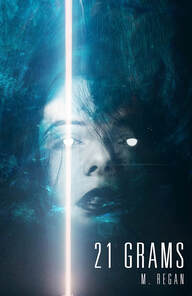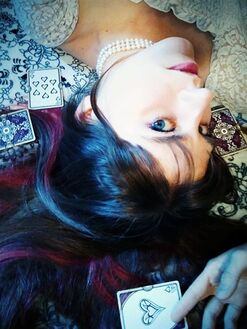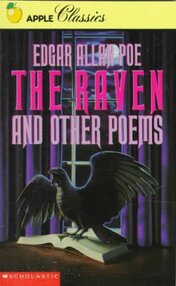|
Hey there, TJ. Thank you for taking the time to talk about your latest book, The Lamentations of Blackhawk. Before we get into that, though, I want to ask some questions so readers can get to know you better. How many books have you written so far? I have five published books so far (three novellas and two collections). There is another novel and a book of essays that are basically finished, but just sitting around. They may never see the light of day. There are a handful of anthologies I'm in and in 2022, I had an essay in FANGORIA, which was a bucketlist accomplishment for me. A lot of them take place in Utah. Why is that? I grew up in Utah and for a long time I avoided writing about it or setting anything there. Then, while living in Las Vegas, I had a story in my head I couldn't escape and it would have been an injustice to the story to set it anywhere else. After that, I embraced Utah as a setting for my stories. Utah people are the people I know best and those places inhabit a sort of twilight zone for readers. They are either just as familiar or so foreign to readers that I can get away with a lot that I might not be able to do honestly with a different setting. Utah is a place people think they know but is wide open for the horror field. I love the burgeoning Utah horror scene. The state has been dominated by fantasy fiction (religiously influenced and not) for far too long. It's time for the things that go bump in the night to take over. What got you into the horror genre? This is one of my favorite questions. I was born on Halloween. I loved trick-or-treating as a kid, but for a long time, I would get scared and bail. One year, I was taking birthday party invitations to friends and that included one friend who I hadn't seen in a while because we moved to another part of town. He was having his birthday party and that included a trip to a haunted house. There was supposed to be a kid-friendly side. I came out of there white as a ghost and will never forget it. I was heading into my sixth birthday. Fast forward. I had a friend when I was 11 whose parents let him--and me--watch whatever we wanted. So one day we watched MISERY. I fell in love. I went to the library and the librarians didn't blink that I was checking out MISERY the novel. I'd read Poe and Sherlock Holmes before, but King was new territory. I've never let go of my love of horror since then. What sparked your interest in writing? Did you know from a young age that you wanted to be a writer, or did it kind of occur over time? When I was in sixth grade, the Scholastic Book order forms did a contest to finish an R.L. Stine story. (King had done the same thing in the 1970s in a men's magazine.) I wrote mine and entered the contest. I did not win. What I did get, though, was a recommendation by the English teacher to a young writers conference at Utah State University. There was a keynote speaker who was probably important, but I don't remember who it was. All of the young writers were put in groups and we read our stuff for some judges. It might have been an actual competition but if it was, I didn't win that, either. I read my story and really put everything I had into the reading. I had this combined moment of writing an effective story and performing it. I did a lot of theater, but writing was always the place I came back to. As a writer, I am every character, I'm the director and set designer, and the music supervisor. As an actor or even a director, one gets limited in the roles. As a writer, one gets to do everything. Tell us about The Lamentations of Blackhawk. What is it about? The Lamentations of Blackhawk is about a small Utah town that has more secrets than it is willing to give up. The story brings together characters from other books to fight demons and ghosts and other people. It's about dealing with the past at a moment when the present is trying to kill you. That's super vague, but it's just not as easy to pinpoint exactly what it is about in easy terms. I've read your other books, Cry Down Dark and Tell No Man. Without spoiling anything, there is a lot of crossover in Blackhawk with those other two books. Did you know when you started Cry Down Dark that it would end up like this? No, I didn't. I never intended to write a sequel or a trilogy as it stands now. Cry Down Dark touches on the town of Blackhawk but most of the action is somewhere else. With Tell No Man, I purposefully decided to dive into the Blackhawk I had created. The ending of that book leads naturally to The Lamentations of Blackhawk, so that was more planned. At the beginning, though, no. It seems like the right thing to do. It's King coming back on me. One can read the Castle Rock/Derry books and see the references to other stories but that doesn't mean we're stuck reading them in that certain order. Readers can take Cry Down Dark or Tell No Man in either order before reading The Lamentations of Blackhawk. I like the crossover, even if that wasn't the original goal. But unlike some long-running fantasy and horror series', the books are still short. Is there anything that surprised you while you writing The Lamentations of Blackhawk? I'm always surprised, because I am telling myself the story first. The big surprise for me was a character who popped up when Peter Toombs (first in Cry Down Dark) goes back to the town in which that book is set. The character is based on a campfire tale I'd heard when I was a Boy Scout. Classic urban legend style story and there he was, like he was waiting for me to use him. What are you working on now? I have two works in progress. The first is a nonfiction project currently titled Holding Out for a Hero: Forty Years after Footloose. Blackhawk is based on Payson, Utah, where I did most of my growing up. The 1984 film Footloose was filmed there and the surrounding area, so I am writing about it. The second is another novel, currently titled Do Not Forsake Me. Trying my hand at horror westerns for that one. We might even see Blackhawk in its earliest days. If things stay on track, it will be the bloodiest things I've written. Where can readers and fans follow you? The best place to catch up with me is my own website www.tjtranchell.net, but I am still active on social media. @TJ_Tranchell for Twitter and @TJ-Tranchell for Instagram. If I ever try out the new platforms, my site is where I will announce that. Thanks for having me and we'll catch you on the flipside. T.J. Tranchell was born on Halloween, has worked as a journalist, horror movie columnist, pizza delivery man, warehouse worker, haunted house monster, customer service clerk, college instructor, and other less glamorous jobs. Tranchell has his master’s degree in literature from Central Washington University with, naturally, a focus on the horror genre. Tranchell published his first novel, “Cry Down Dark,” through Blysster Press in 2016. In 2017, Blysster released a collection of short stories, poetry, and film criticism titled Asleep in the Nightmare Room. 2020 saw the release of a second collection, The Private Lives of Nightmares, followed soon by his second novel Tell No Man, which he published under his imprint LAST DAYS BOOKS. He has also published horror short fiction and was co-editor of GIVE: An Anthology of Anatomical Entries, a dark fiction anthology from When the Dead Books. He is a rising star among horror scholars, having presented work on Stephen King at the Popular Culture Association’s national conference, and in 2021 at the Ann Radcliffe Conference on the “Great American Horror Novel.” He currently teaches English at a community college in Washington state. Email him at [email protected].
by Stephanie M. Wytovich In the past decade or so, speculative poetry has presented itself in the marketplace as an equal and valid contender in the field, thereby solidifying its place in the world of publishing, both large and small. Readers now not only enjoy it in magazines and individual collections, but also in anthologies, craft books, and in nonfiction articles exploring its value, voice, and contribution to science fiction, fantasy, and horror. Two great examples of this are the recently relaunched Weird Tales and the 2021 Halloween issue of Southwest Review edited by Andy Davidson. When I started out as a fledgling poet, I turned first to The Science Fiction and Fantasy Poetry Association (SFPA), and all these years later, I remain a member in this community that continues to celebrate poetry in all its different forms. When I first heard about the SFPA, I quickly researched their website, joined their Facebook group, and signed up for my yearly membership. As someone new to speculative poetry—not to mention someone who didn’t even know that speculative poetry was an avenue to pursue at the time—I devoured the listing of current markets they had and still have on their website, careful to make note of which magazines spoke to me and the work I was doing. I began submitting to their own magazine, Star*Line, and then discovered the themed work they did with Eye to the Telescope. Later on, I learned about the Rhysling Award, the Dwarf Stars, and the Eglin Award and was fortunate to have some of my work published in subsequent anthologies while my book Mourning Jewelry placed third in the Elgins in 2015. I bring this up because the opportunity to read for these awards and get to know and network with fellow poets was not only inspiring but a kind of professional development in and of itself. I had never formally studied poetry, but I learned and continue to learn so much from this group and it’s provided me editorial opportunities, such as with Issue 17 of Eye to the Telescope, promotional outlets, and camaraderie in a career that is not only isolating but quite lonely at times. Similar to the SFPA, my involvement with the Horror Writer’s Association (HWA) has proven invaluable to my life blood as a poet. From the Bram Stoker Awards to the HWA Poetry Showcase to the HWA Poetry Blog and then the Dark Poetry Scholarship, the HWA has worked hard to include, promote, and educate writers about how horror poetry can supplement their writing career and lead to a road of publication and higher learning. Similar to the SFPA, HWA members have countless opportunities to publicize their work and/or events, contribute to a variety of initiatives, and teach/attend continuing education workshops. Furthermore, when I attend Stokercon, there are always panels that discuss the state of speculative poetry, or that talk about the intersection of horror, writing, and mental health, and whether I am listening in the audience or contributing to the discussion, the conversation around poetry is always present and well-attended, proving that the form is not dead, but rather very much alive. If you’re interested in getting more involved in the speculative poetry community, I highly recommend checking out the organizations above, volunteering where you can, and continuing to submit your work frequently. Please note that there are also mentorship opportunities, board positions, jury seats, and editorial work to be sought out, so there are lots of ways to contribute to the market, the genre, and get more involved in the work that’s being done. Afterall, if we want to continue to see poetry flooding the markets, we need to nourish the communities that support it while also educating and promoting each other’s work.  Stephanie M. Wytovich is an American poet, novelist, and essayist. Her work has been showcased in numerous magazines and anthologies such as Weird Tales, Nightmare Magazine, Southwest Review, Year's Best Hardcore Horror: Volume 2, The Best Horror of the Year: Volume 8, as well as many others. Wytovich is the Poetry Editor for Raw Dog Screaming Press, an adjunct at Western Connecticut State University, Southern New Hampshire University, and Point Park University, and a mentor with Crystal Lake Publishing. She is a recipient of the Elizabeth Matchett Stover Memorial Award, the 2021 Ladies of Horror Fiction Writers Grant, and has received the Rocky Wood Memorial Scholarship for non-fiction writing. Wytovich is a member of the Science Fiction Poetry Association, an active member of the Horror Writers Association, and a graduate of Seton Hill University’s MFA program for Writing Popular Fiction. Her Bram Stoker Award-winning poetry collection, Brothel, earned a home with Raw Dog Screaming Press alongside Hysteria: A Collection of Madness, Mourning Jewelry, An Exorcism of Angels, Sheet Music to My Acoustic Nightmare, and most recently, The Apocalyptic Mannequin. Her debut novel, The Eighth, is published with Dark Regions Press. Follow Wytovich on her blog at http://stephaniewytovich.blogspot.com/ and on Twitter and Instagram @SWytovich and @thehauntedbookshelf. You can also find her essays and nonfiction on LitReactor. When Timber Ghost Press first opened for business, we also opened for novel and novella submissions. We waded through the first few waves of submissions. Some of the stories didn't quite fit the tone we wanted to portray here at Timber Ghost. Some didn't quite make the mark. However, there was one submission that stood out in that first wave. That submission was 21 Grams by M. Regan. Their writing, voice, tone, and atmosphere was spot on. The story itself is beautiful, harrowing, and horrifying in so many different ways. Of course we had to say yes and publish it. Fast forward to today, and 21 Grams continues to garner praise and love from its readers. It got us thinking though, what influenced M. Regan? That led us to the question, what top five authors or books influenced you the most. Read on to find out. “Embarrassed” isn’t the right word. It’s not that I’m embarrassed. But there is a consensus of generally agreed-upon Influential Horror Writers (trademark pending) with whom credible authors are meant to align themselves. When such an author is asked, “whose work do you admire” or “whose work inspired you,” there ought to be at least one literary great thrown in there, if but to showcase the respect that is felt for this genre’s longstanding roots. Which brings us to a definitely-not-embarrassing confession from me, a person who is trying very hard to be a credible author: I don’t really care for any of the Influential Horror Writers (trademark pending). That isn’t to say I haven’t been informed by them or their work. There is, for example, a great deal of Mary Shelley’s influence in my debut novella, 21 Grams. That was entirely by design. And anyone who has a passing familiarity with my short stories will suspect I sold my soul to publish so many pieces that pay homage to Faust. I can— and do— acknowledge horror’s erudite sires. (I also pay my dues to the HWA, and make the appropriate ritual sacrifices when the stars are in alignment. I really am trying, here.) The issue, as it were, is that these foundational texts were not the foundation that I, as a young and impressionable reader, constructed my inner worlds upon. Instead, my teeth were cut on media that had been derived from them: that had taken and twisted those ideas and themes into tales more grandiose, more controversial, more depraved, more relevant, more innovative. By the time I was old enough to appreciate the source material, those original works felt very basic by comparison. They did not surprise me. They did not delight me. They did not do that which I most desire from the media I consume: They did not make me think. “Speaking of thinking,” you might now be muttering to your screen, “why do you think I care about your opinions on stories?” That is a very good question. And the answer is: you shouldn’t care! What do my feelings on this topic matter? You do you, as a great philosopher once said. If I don’t like something, more of that something for you to enjoy! Have at it and have fun. However, for those of you who think they might be interested in doing a bit more thinking, I offer humbly unto you: 5 Pieces of Horror/Horror-Adjacent Media That I Found Exceptionally Thought-Provoking GOTH by Otsuichi / translated by Andrew Cunningham (Novel) Originally published as a series of novelettes, this translated compilation of Japanese horror follows a pair of high schoolers who forge a permanent bond over their shared interest in darkness, death, and the endless parade of murders that just-so-happen to take place in their town. Think “Scooby Doo,” but the mysteries come to them. Also, Fred is a sociopath. This might be the time to admit I don’t know a ton about “Scooby Doo.” GOTH is a book about many things, but definitely not friendship. For people who enjoy stories about “man being the monster”— possibly literally— I cannot recommend this collection highly enough. The Bartimaeus Sequence by Jonathan Stroud (Novels) “But Regan,” you say, “I’ve just looked it up. This is a young adult series about magicians. It’s listed as a fantasy. It’s not horror at all.” To which I look you dead in the eyes, unblinking, for a solid 10 seconds before asking, “Have you read it?” Set in an alternate-universe London where the government is comprised of magicians, The Bartimaeus Sequence follows a young and ambitious boy named Nathaniel as he follows his political dreams with the (often begrudging) help of a snarky 5,000-year-old djinni named Bartimaeus. It is comedic, it is cutting, and there are scenes within its pages that scare me to this day. But more than that, it is important, exploring in explicit detail themes of exploitation, slavery, government corruption, and systemic abuse of the disenfranchised. I am on my knees begging you to toss your copies of Harry Potter and pick up Bartimaeus instead. Puella Magi Madoka Magica by Magica Quartet (Anime) In many ways, I’m being a bit of a hypocrite by including this one. But when Madoka first aired in 2011, it was revolutionary in the way it reinterpreted the “magical girl” genre. And unlike, say, the original books and plays about Faust, I happened to be around for this one. Hey, here’s a segue for you: For what wish might you sell your soul? Made of sugar, spice, and crushing existential horror, Puella Magi Madoka Magica is a phenomenally written and gorgeously produced animation that is sure to appeal to those who want a few more decapitations in Sailor Moon. From the New World (Shinsekai Yori) by Yusuke Kishi / A-1 Pictures (Anime) Set one thousand years after a telekinetic apocalypse has destroyed the world as we know it, a group of friends begin attending their local psychic school. But what about the other children in their town, the ones whose mental powers never manifest? What waits in the forests outside the utopian Kamisu 66? And what, ultimately, does it mean to be human? I was employed by Crunchyroll as a localization editor for a time, and of all the series I was privileged enough to work on, this was the one that most blew my mind. The Magnus Archives by Jonathan Sims (Podcast) A veritable shrine to all knowledge paranormal and esoteric, the Magnus Institute is an academic organization dedicated to the pursuit of supernatural research. They also have an exceptionally messy archive. Determined to derive order from chaos, the Institute’s new archivist, Jonathan Sims, has decided to try and digitize the written statements of people who claim to have experienced strange happenings. And from there— as if from the hub of a great web— the red threads start to spread, and tangle, and knot. This podcast is what sustained me through the beginning of the covid pandemic. Not to put too fine a point on it, but it is one of the most intricately crafted and phenomenally executed stories that I have ever been told, and I cried for four and a half days when it ended. If you are a fan of creepypasta, cosmic horror, and casual queer representation, give it a listen; there is a reason that this show has racked up so many awards. Well, then— I’ve shown you mine. Any interest in showing me yours? What stories have haunted you the longest? Which series have made homes in your brains? Which media have you found the most thought-provoking? Let me know! Give me something new to think about! M. Regan has been writing for over a decade, with credits ranging from localization work to short stories to podcast scripts. Fascinated by the fears personified by monsters, they enjoy dark fiction, studying supernatural creatures, and traveling to places rich with folklore. Find them on Twitter and Facebook.
Our next guest post comes from John Ryland. What's scarier, a monster that defies imagination? Or is it the next door neighbor who only comes out at night and stares at your window for hours? John Ryland delves into this topic and more... sometimes, real life is scarier. Horror in Real Life by John Ryland People aren't afraid of being alone in the dark. They're afraid of NOT being alone in the dark. Some of the scariest moments of my life have been in my own home, alone, late at night. There's a noise outside. It could be the wind, or it could be a masked murderer. There's really only one way to find out. I love horror movies. I love the monster movies too. They're scary, but not horrifying. For me, the possibility that my monster could really exist is what makes it scary. A psychopathic wanderer, a neighbor with an obsession. Things that probably won't happen, but could, terrify us. Let's face it, there's probably not going to be an alien invasion or a zombie hoard attacking your house, the notion is scary, but it won't keep you up at night. The fact that someone might be outside in the dark, watching you, definitely will. When I write, I always try to create normal people. People with flaws that we can identify with. A tick. A mannerism. That makes them real. Then I like to take those ordinary people and put them in extraordinary situations and have them react. I think people find themselves rooting for the normal people and that invests them emotionally in the work. It's been said that if you can get people to invest in your characters, then make them uncomfortable, then stir their emotions, then bring them to a reasonable conclusion, you'll have a fan for life. That's what I hope to do. I also like to make people wonder if I'm okay. I love to write big, dramatic scenes with angst and turmoil that make people make faces while reading. If a reader's face never changes during a book, I'd consider it boring. I want to make your facial expression run the gamut of emotions, even if you end up wondering if something might be wrong with me, upstairs. There's not, clinically speaking anyway. I love the "Aha!" moment, when the characters piece things together and realize that not only is it possible for this strange thing to be happening, but that it is indeed happening to them. There are so many strange things in this world, ramping them up just a bit for literary purposes doesn't make them less real. But above all else, I want to entertain. Rollercoasters are fun, whether literally or in a book. They get your heart beating faster, surprise you, scare you. They take you away, if only temporarily. I hope I am able to do that because ultimately, without readers, we're all just a bunch of nuts banging away at a keyboard for no reason. This article originally appeared on John's blog. You can find it here: https://www.gspressbooks.com/post/horror-in-real-life John Ryland lives in Northport Alabama with his wife and two sons. He has had ten short stories published in journals over the last two years. John has also self published two novels and a collection of short stories, as well as a poetry chapbook. He is currently under contract to have two books traditionally published in 2022. Find more of John's work at gspressbooks.com or follow him on social media.
https://twitter.com/johnryland10 https://instagram.com/ryland364 https://facebook.com/JRylandtheWriter I can’t remember the first time I went to a bookstore. I mean a store whose central product is books. Growing up in rural parts of Utah, I had the Scholastic Book order forms, like so many others of my generation. I don’t think Scholastic gets the credit they deserve for being a publisher of gateway horror. My first copy of Scary Stories to Tell in the Dark came from them, as did the gloriously skeletal—but ultimately disappointing--The Train by Diane Hoh. My memory wants me to believe Scholastic published Christopher Pike, too, but I never bought any of those. Two other things found in the book order form helped make me the horror writer I am today. I still have the first copy of Edgar Allan Poe works I ever bought. The Raven and Other Poems was an Apple Classic from Scholastic and, as you can imagine, the cover was gloriously purple. I must have known something about Poe before buying it, but I don’t remember. “The Raven” hypnotized me and “Annabelle Lee” made me cry, although I didn’t fully understand it at the time. I had not read much poetry outside of Shel Silverstein—a good precursor to reading Poe, in my opinion—and so it took some getting used to the format. The slim volume was only poetry and so I would soon search out the short stories and began to notice how often Poe showed up in other media. I remember one episode of the sitcom Cheers in which Carla invoked the spirit of “The Tell-tale Heart” to freak out someone else at the bar. Later there would be The Simpsons epic version of “The Raven” pitting Homer against Bart the raven. Around this time, ages nine to 13, I truly began to embrace horror. I had been a casual fan and a sufferer of nightmares. But my birthday is on Halloween, and I soon sickened of other people scaring me. It was my turn. Re-enter the Scholastic book order form. During my sixth-grade year, Scholastic sponsored a contest to complete an unfinished R.L. Stine story. Later, as Stephen King took over my reading life, I learned that King had done the same thing with a men’s magazine in the 1970s. “Finish this story,” beckoned the flimsy catalogue. So I did. I took Stine’s story of basement experiments and paternal secrets and created a Moreau-esque bird monster. I did not, however, win. I could consider this my first rejection but more importantly, it was the first real story I finished. The Goosebumps book that Stine’s start later became featured sentient and monstrous plants, not a birdman, so at least he didn’t steal my idea. Someone won that contest and I hope they stayed the course and became a writer. What I got out of that story, besides the important act of finishing something, was a nomination by my teacher and acceptance to the Utah State University young writers conference. My mom and I got to spend the day on the college campus. Somebody gave a speech, we were given lunch, and I got a medal. We also got to hear other participants read their stories and essays. We heard quite a bit of monotone reading, but I wanted to scare people. That was my first public reading. Gasps at the scary parts and a round of applause and that was it for me. Even though I didn’t immediately devote my life to writing, I always craved the applause… and the screams. I’ve done theater and worked in haunted houses. Those are all collaborative experiences. I might be the focus in the moment, but there’s a mask or a character between me and the audience. There’s the set and maybe music. During a reading, it’s only me and the words I put down on paper. A reading is a performance. I’ve read about Poe’s public readings and attended a large outdoor reading by Stine. I know they both understand. Without them, and the access to their work via the Scholastic book orders, you wouldn’t be reading this now.  T.J. Tranchell was born on Halloween and grew up in Utah. He has published the novella Cry Down Dark and the collections Asleep in the Nightmare Room and The Private Lives of Nightmares with Blysster Press and Tell No Man, a novella with Last Days Books. He has been a grocery store janitor, a college English and journalism instructor, an essential oils warehouse worker, a reporter, and a fast food grunt. He holds a Master's degree in Literature from Central Washington University and attended the Borderlands Press Writers Boot Camp in 2017. He currently lives in Washington State with his wife and son. Follow him at www.tjtranchell.net. |
Archives
June 2024
Categories
All
|






 RSS Feed
RSS Feed